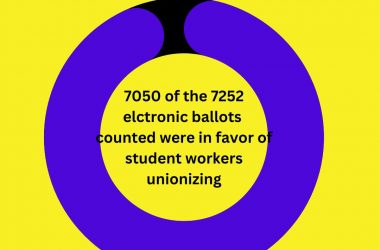
The California State University system has embraced open educational resources in its attempts to make course materials available digitally at a more affordable cost for students. CSU’s recent collaboration with VitalSource will give students’ access to academic and workplace content through the BookShelf app at a lower price than print material.
Open educational resources are content available online, usually free or at a low cost, that is meant for academic or research purposes. Whereas both open educational resources and digital textbooks have copyright licenses, OERs operate with a Creative Commons License, which allows users to modify or revise the resource.
“If we can reduce cost of textbooks, then students who can take more units per semester could graduate in a timely manner,” said Gerry Hanley, the CSU assistant vice chancellor for Academic Technology Services. “We’re trying to help our students graduate faster, so they can get out to the job market more quickly, so they are paying less tuition and so they can enjoy life after school sooner.”
Usually instructors who author OERs don’t receive revenue, but are compensated through grants by the universities that pay them to write the materials as part of a scholarly activity. This was due to an assembly bill passed California dubbed the College Textbook Affordability Act, which established a program that rewarded campuses and faculty members who adopted OER.
In addition, starting January 1, 2018, California will require the CSUs, California community colleges and the University of California system to communicate to students of free course materials in online course schedules. This mandate is part of a senate bill passed in late 2016 concerning reduced cost of course materials.
VitalSource, an Ingram Content Group company, recently became a big platform in the distribution of e-textbooks for universities. According to Hanley, the public university system has been in collaboration with Ingram and VitalSource for more than a decade.
This move is a continuation of the CSU’s push for finding affordable learning solutions for students. Three years ago, the CSU system helped start the California Open Online Library for Education, which encompasses more than 50 courses with each discipline having between one and seven textbooks available for free digitally. In 2014, the CSU created a national repository of OERs for workforce development, which was funded by the U.S. Department of Labor.
“The CSU has become the major distributor of OER resources,” Hanley said. “We thought it was an opportune time for us to collaborate on ways to distribute OERs through the VitalSource channel.”
In conjunction with the Graduation Initiative 2025, the CSU has adopted a separate program with VitalSource called CSU Rent Digital. The program offers rentable online textbooks at a cheaper price than print textbooks.
Though the CSU is pushing toward online textbooks and OERs, the percentage of faculty that use those resources is still low.
Rico Ovalles, Textbook Assistant Manager for the Forty-Niner Shops, estimated about 70 percent of instructors still use print textbooks, while only between eight and nine percent have adopted digital. But Ovalles is cautious with the numbers since they may be inflated or abridged, because there is anonymity within the 21 percent who did not reply.
“Right now, around 8.5 percent faculty adopted digital this semester,” Ovalles said. “Three or four years ago it was around three percent, and five years ago it was around one percent.”
According to a faculty watch survey conducted in the past academic year, more than 50 percent either didn’t know what OER’s are or expressed no interest in taking them on. Thirteen percent of the professors surveyed believed that in the next five years, OER’s would only be useful in a few disciplines.
Use of technological resources is gradually on the rise, but professors who have gone digital credit students as motivation for the switch.
Journalism assistant professor Gwen Shaffer says she doesn’t want her students to spend too much money in her class.
Shaffer teaches her Internet Policy class using an open-source e-book. The book has a recommended $35 donation to the publisher and although she encourages her students to pay for it so the publisher can keep functioning, she acknowledges that they don’t have to.
“Typical case-law books are a couple hundred dollars, and I didn’t want my students to have to invest that much,” Shaffer said. “My class is a general ed class, so it’s not a textbook they’ll be using routinely in other classes. [Also], e-books are more environmentally friendly. Students can print out just the pages they need.”
Asian American History lecturer Truc HaMai believes students can’t rely just on a textbook to be fully aware of history.
“There is so much available academic material for students to access that is beyond the traditional textbook,” HaMai said. “There are books, journals and news articles.”
HaMai teaches her course using a $10 textbook, which can be found online as an e-text, and online supplemental materials, including YouTube videos and news articles.
As a result of CSU’s shift toward electronic material, the bookstore division of Forty-Niner shops is gradually losing revenue.
Jared Ceja, director of the bookstore division of Forty-Niner shops, says the bookstore makes $5 million annually in course material revenue, which is just a fraction of what it used to generate 20 years ago. But most of that money goes to other expenses.
“More than $4 million of the revenue goes to pay the book publishers,” Ceja said. “Then you have [to pay for] shipping, employee and staff, student workers, overhead expenses and the point of sale system. At the end of the year, the bookstore [makes] $95,000 in net revenue. But we … use that money for student scholarships, infrastructure projects and departmental support.”
But Ceja and Kierstin Stickney, director of marketing and communications for Forty-Niner Shops, maintain that student success and sustaining operations are top priorities.
“Every year is tougher since [the bookstore] operate with a pretty lean staff,” Stickney said. “We work around the clock and almost every department could use at least three or four more full time people. We don’t make a lot but we do enough just to get by in order to assist the campus and make sure the CSULB community is taken care of to the best of our ability.”



